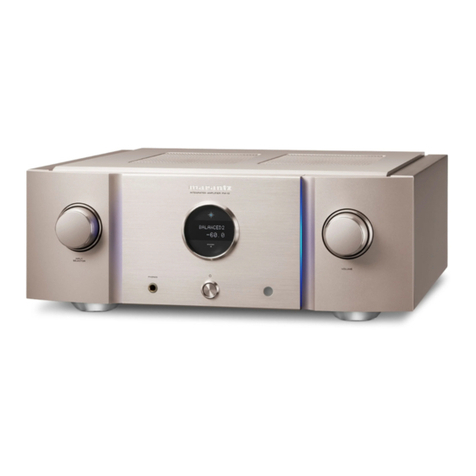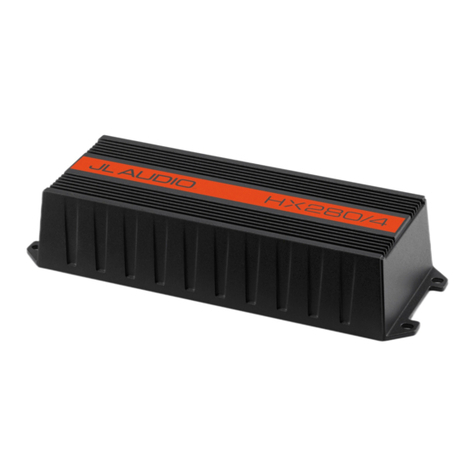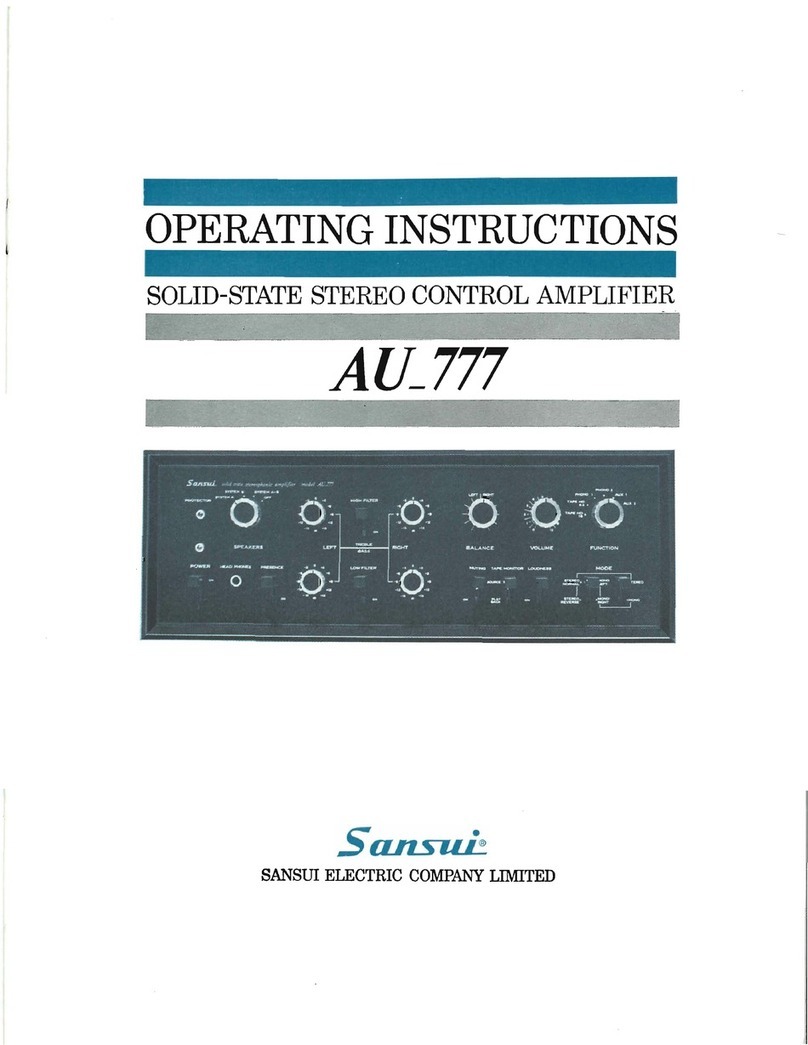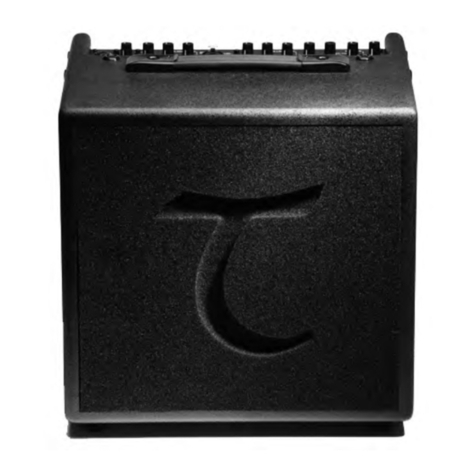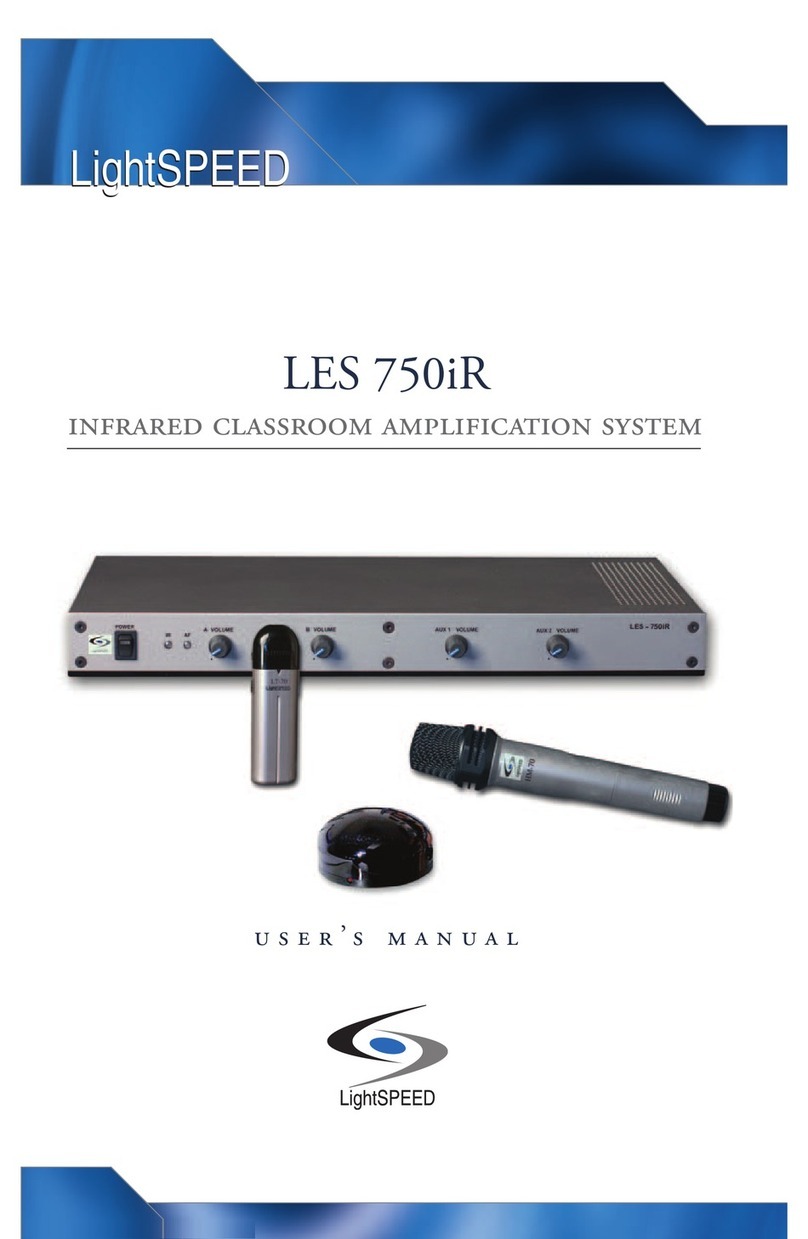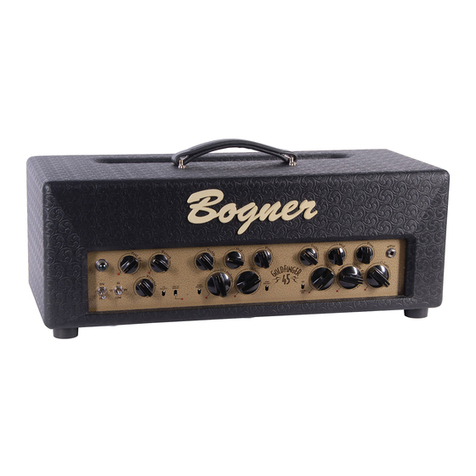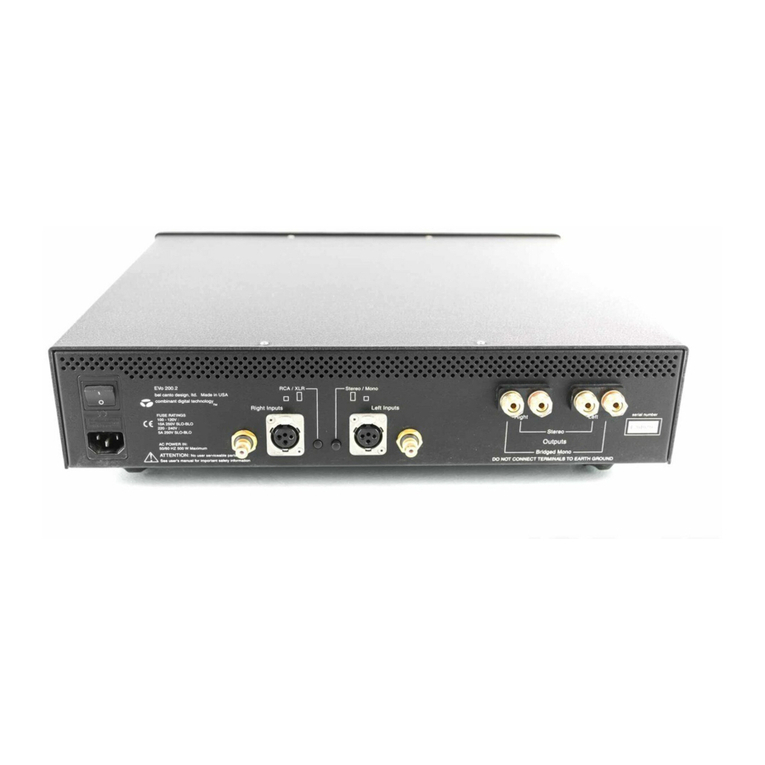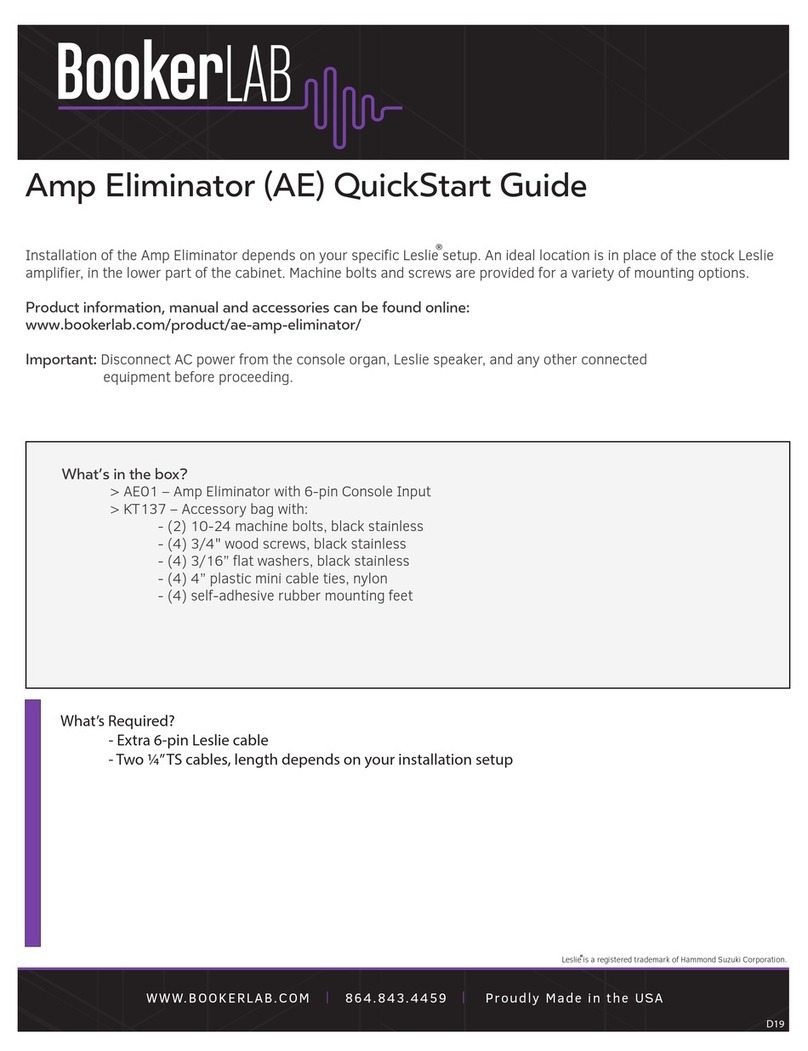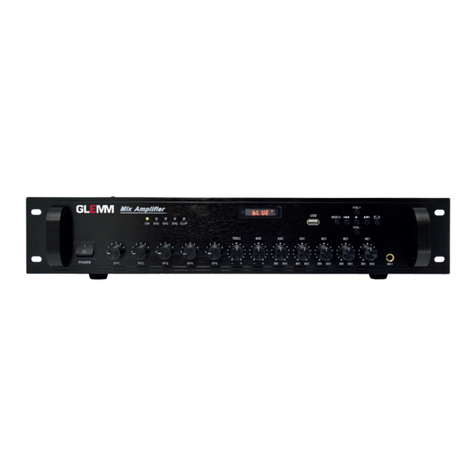Garmin Fusion Apollo MS-AP41200 User manual

Fusion®Apollo™Multichannel Amplifiers Installation Instructions
Important Safety Information
WARNING
See the Important Safety and Product Information guide in the product box for product warnings and other
important information.
This device must be installed according to these instructions.
Disconnect the vessel's power supply before beginning to install this device.
CAUTION
Continuous exposure to sound pressure levels over 100 dBA may cause permanent hearing loss. The volume is
typically too loud if you cannot hear people speaking around you. Limit the amount of time you listen at high
volume. If you experience ringing in your ears or muffled speech, stop listening and have your hearing checked.
To avoid possible personal injury, always wear safety goggles, ear protection, and a dust mask when drilling,
cutting, or sanding.
NOTICE
YOU MUST NOT USE THIS AMPLIFIER WITH ANY THIRD-PARTY MARINE AUDIO SYSTEMS. This amplifier is
compatible only with Fusion DSP-enabled marine audio equipment and may cause damage to third-party
speakers due to the amplifier power output.
When drilling or cutting, always check what is on the opposite side of the surface to avoid damaging the vessel.
It is strongly recommended that you have your audio system installed by a professional installer to ensure
optimum performance.
You must read all installation instructions before beginning the installation. If you experience difficulty during
the installation, go to support.garmin.com for product support.
After installing an audio system, you should run the connected speakers and subwoofers at low to medium
volumes for the first few hours of use. This helps to improve the overall sound by gradually loosening up the
moving components of new speakers and subwoofers, such as the cone, spider, and surround. See the
installation instructions provided with your speakers, because there may be more details about the
recommended time for each model.
NOTE: After installing the amplifier, you must set up your connected stereo using the Fusion-Link™ app to select
and activate the correct DSP profile.
GUID-12BC9614-2882-4A6F-A581-2894A8B33AAD v3September 2021

Tools Needed
• Drill and 3 mm (1/8 in.) drill bit (or a drill bit appropriate for your provided mounting hardware and mounting-
surface material).
• Screwdrivers:
◦5 mm (7/32 in.) flat (slotted)
◦4 mm (5/32 in.) flat (slotted)
◦3 mm (1/8 in.) flat (slotted)
◦#2 Phillips
◦#0 Phillips
• Wire cutter
• Wire stripper
• Wires and cables:
◦4 AWG (21 through 25 mm2) marine-grade, fully-tinned copper wire for power and ground
NOTE: You may need larger-diameter (smaller gauge number) wire for longer runs to account for voltage
drop (Connecting to Power, page 9)
◦16 AWG (1.3 through 1.5 mm2) marine-grade, fully-tinned copper wire for standard speakers
You can purchase this wire from your Fusion or Garmin® dealer:
◦010-12899-00: 7.62 m (25 ft.)
◦010-12899-10: 15.24 m (50 ft.)
◦12 AWG (3 through 4 mm2) marine-grade, fully-tinned copper wire for full-range speakers or subwoofers
using the high power adapter
You can purchase this wire from your Fusion or Garmin dealer:
◦010-12898-00: 7.62 m (25 ft.)
◦010-12898-10: 15.24 m (50 ft.)
NOTE: You may need larger-diameter (smaller gauge number) wire for longer runs of speaker or
subwoofer wire.
◦20 AWG (0.5 through 0.75 mm2) marine-grade, fully-tinned copper wire for the remote-on signal
◦2-channel RCA cable (1 per stereo channel pair) (Signal and Speaker Connection Considerations,
page 11)
◦1-channel RCA cable (1 per mono channel) (Signal and Speaker Connection Considerations, page 11)
You can purchase a suitable length of RCA cable at garmin.com/apollo_amplifier_accessories or from
your Fusion or Garmin dealer.
• Cable ties (optional)
2 Fusion Apollo Multichannel Amplifiers Installation Instructions Installation Instructions

Mounting Considerations
CAUTION
In high ambient temperatures and after extended use, the device enclosure may reach temperatures deemed
dangerous to touch. To avoid possible personal injury, the device must be installed in a location where it will
not be touched during operation.
NOTICE
This device should be mounted in a well-ventilated location that is not exposed to extreme temperatures or
conditions. The temperature range for this device is listed in the product specifications. Extended exposure to
temperatures exceeding the specified temperature range, in storage or operating conditions, may cause device
failure. Extreme-temperature-induced damage and related consequences are not covered by the warranty.
If you are mounting the device on fiberglass, when drilling the pilot holes, use a countersink bit to drill a
clearance counterbore through only the top gel-coat layer. This will help to avoid cracking in the gel-coat layer
when the screws are tightened.
This device is designed for installation only in a dry location. Installing this device in a location where it may
come in contact with more than occasional dripping water or become submerged may result in damage. Water
damage is not covered by the warranty.
You can mount this device using one of two methods:
• You can use the included bracket and pan head screws to mount the device (Installing the Mounting Bracket,
page 4).
◦Mounting the device using the bracket allows you to quickly attach and detach the device from the
mounting surface.
◦Mounting the device using the bracket requires clear space above the mounting location to allow for
connecting the device to the bracket and installing the locking wedge.
• You can use the included flat-head, countersunk screws to mount the device directly to the mounting surface
(Mounting the Device Directly to the Surface, page 7).
◦Mounting the device directly to the surface does not allow you to quickly detach the device.
◦Mounting the device directly to the surface does not require as much clear space above the mounting
location, so it may be a more suitable choice for installing in a smaller space.
When selecting a mounting location, observe these considerations:
• You must mount the device in a location that does not interfere with the fuel tank or electrical wiring.
• You must mount the device in a location where it is not exposed to water.
• You must mount the device in a location where it is not exposed to fuel or fuel vapor.
• You must mount the device in a location with adequate ventilation where it is not exposed to extreme
temperatures.
• If you mount device in an enclosed space, you should install a cooling fan with appropriate ducts to aid in
airflow.
• You should mount the device so that the cables can be connected easily.
• To avoid interference with a magnetic compass, you should mount the device the specified distance away
from a compass. This distance is listed in the specifications section.
• You must not mount the device in close proximity to other navigation-critical equipment, antennas, or radio-
communication equipment on the vessel.
Fusion Apollo Multichannel Amplifiers Installation Instructions Installation Instructions 3

Installing the Mounting Bracket
NOTICE
Pan-head screws are included, but they may not be suitable for the mounting surface. If you provide different
mounting hardware, you must not use fasteners with a countersunk head. Hardware with a countersunk head
will damage the mounting bracket.
Before you install the mounting bracket, you must select a mounting location and determine what screws and
other mounting hardware are needed for the surface.
Mounting the device using the mounting bracket allows you to quickly attach and remove the device as needed.
1Use the included template to verify that the mounting location has sufficient clearance to install the device.
NOTE: You must install the bracket with the release tab pointing up to properly secure the amplifier in the
bracket.
2Using a 3 mm (1/8 in.) bit or a bit appropriate for your provided hardware and mounting-surface material, drill
the pilot holes marked on the template.
NOTICE
If you are mounting the device on fiberglass, when drilling the pilot holes, use a countersink bit to drill a
clearance counterbore through only the top gel-coat layer. This will help to avoid cracking in the gel-coat
layer when the screws are tightened.
3Using the included pan-head screws or other pan-head mounting hardware, secure the bracket to the
mounting surface.
NOTICE
You must use pan-head screws, because countersunk screws will damage the bracket.
4 Fusion Apollo Multichannel Amplifiers Installation Instructions Installation Instructions

Connecting the Device to the Mounting Bracket
You must secure the mounting bracket to the surface before you can connect the device.
1Hold the device over and slightly above the mounting bracket.
2Place the device onto the bracket and pull down until the tab audibly clicks.
3Insert the wedge over the tab on the top of the mounting bracket it and push down to lock the device in the
bracket.
4Install the included screw covers in the four holes on the top of the amplifier (optional).
Fusion Apollo Multichannel Amplifiers Installation Instructions Installation Instructions 5

Removing the Device from the Mounting Bracket
1Lift up to remove the wedge, which unlocks the tab on the mounting bracket.
2Press the tab on the mounting bracket, and lift up on the amplifier to disconnect it from the mount .
6 Fusion Apollo Multichannel Amplifiers Installation Instructions Installation Instructions

Mounting the Device Directly to the Surface
If you are installing the device in a location with limited space, or you do not want to use the bracket, you can
mount the device directly to the surface.
NOTE: Countersunk screws are provided to mount the device directly to the surface. If you choose to use your
own hardware to mount the device directly to the surface, countersunk heads are recommended.
1Using the provided template, mark the pilot hole locations for the four mounting holes on the device,
observing these considerations:
• Because you are not using the bracket, you do not need to observe the upper clearance line on the
template.
• You must observe the lower clearance line on the template so that you have the space needed to make
the cable connections.
2Using a 3 mm (1/8 in.) bit or a bit appropriate for your provided hardware and mounting-surface material, drill
the pilot holes.
NOTICE
If you are mounting the device on fiberglass, when drilling the pilot holes, use a countersink bit to drill a
clearance counterbore through only the top gel-coat layer. This will help to avoid cracking in the gel-coat
layer when the screws are tightened.
3Using the provided countersunk screws, secure the device to the mounting surface.
4Install the included screw covers in the four holes on the top of the amplifier (optional).
Connection Considerations
NOTICE
You should turn off the audio system before making any connections to the amplifier. Failure to turn off the
audio system may result in damage to the audio system.
All terminals and connections must be protected from contact with the vessel chassis and with each other.
Improper terminal or wire contact may result in damage to the audio system.
NOTE: You must connect the amplifier to the AMPLIFIER ON wire from the stereo for the amplifier to turn on
and off with the stereo.
Fusion Apollo Multichannel Amplifiers Installation Instructions Installation Instructions 7

Port Identification
MS-AP41200 4-Channel Amplifier
MS-AP61800 6-Channel Amplifier
MS-AP82400 8-Channel Amplifier
Power block port (Connecting to Power, page 9)
Zone 1 speaker block port (Signal and Speaker Connection Considerations, page 11)
Zone 1 RCA input
Zone 2 speaker block port
Zone 2 RCA input
Zone 3 speaker block port
Zone 3 RCA input
Zone 4 speaker block port
Zone 4 RCA input
8 Fusion Apollo Multichannel Amplifiers Installation Instructions Installation Instructions

Connecting to Power
CAUTION
The wiring (not included) from the power source to the amplifier must run through an inline fuse or circuit
breaker (not included) as close to the power source as possible. You must connect the positive wire to the fuse
or circuit breaker. Connecting the amplifier to power without an inline fuse or circuit breaker may result in a fire
if there is a short in the cable.
If the amplifier is powered by a battery, use a breaker or fuse rated to protect a cable of the gauge used to
connect the amplifier to the battery. See the American Boat & Yacht Council (ABYC) standards for the required
fuse or breaker rating.
If the amplifier is powered by a source other than a battery, use a breaker or fuse rated no higher than the max
current of the power source.
You should use 4 AWG (21 through 25 mm2) marine-grade, fully-tinned copper wire (not included) to connect
the amplifier to power and ground for most installations. For long power-cable runs, you should consider using
larger-diameter (smaller gauge number) wire to minimize power loss.
You must connect the REM terminal on the amplifier block to either the AMPLIFIER ON wire from the connected
stereo or to a constant 12 Vdc power source using a switch.
NOTICE
Connecting to the AMPLIFIER ON wire is recommended to avoid damaging your speakers when the stereo
turns on or off.
1Route 4 AWG (21 through 25 mm2) marine-grade, fully-tinned copper ground wire (not included) to the
amplifier and to a ground location on the boat.
2Using a 5 mm (7/32 in.) flat (slotted) screwdriver, connect the ground wire to the GND terminal on the power
connection block.
3Connect the other end of the ground wire to the ground location.
4Route 4 AWG (21 through 25 mm2) marine-grade, fully-tinned copper power wire (not included) to the
amplifier and to the power source, and select an option:
• Install a properly rated in-line fuse on the power wire as close to the power source as possible.
• Identify or install a circuit breaker, as close to the power source as possible, for use with the amplifier
power wire.
CAUTION
Connecting the amplifier to power without the proper inline fuse or circuit breaker as described above and in
the specifications section may result in a fire if there is a short in the cable.
Fusion Apollo Multichannel Amplifiers Installation Instructions Installation Instructions 9

5Using a 5 mm (7/32 in.) flat (slotted) screwdriver, connect the power (+) wire to the PWR terminal on the
power connection block.
6Route a 20 AWG (0.5 through 0.75 mm2) marine-grade, fully-tinned copper remote-on wire (not included)
from the amplifier to the AMPLIFIER ON wire on the stereo.
NOTE: The amplifier and the stereo must connect to a common ground location for the AMPLIFIER ON
signal to function properly.
7Using a 4 mm (5/32 in.) flat (slotted) screwdriver, connect the remote-on wire to the REM terminal on the
power connection block.
NOTICE
You should wait to connect the power terminal block to the amplifier. Make all of the other connections to the
stereo and speakers before completing the connection to power (Completing the Connections, page 15).
10 Fusion Apollo Multichannel Amplifiers Installation Instructions Installation Instructions

Signal and Speaker Connection Considerations
When connecting your stereo and speakers to the amplifier, observe the following considerations:
• All speakers connect to the amplifier using terminal blocks (Connecting Standard Speakers to the Amplifier,
page 12).
• When connecting standard speakers, you should use 16 AWG (1.3 through 1.5 mm2) marine-grade, fully-
tinned copper wire.
• When connecting a full-range speaker or subwoofer using the included high power adapter, you should use
12 AWG (3 through 4 mm2) marine-grade, fully-tinned copper wireConnecting Full-Range Speakers or a
Subwoofer to the Amplifier, page 13.
• Each set of zone speaker terminals on the amplifier is paired to the RCA inputs for that zone.
• Each channel supports a nominal 4 Ohm speaker load impedance, and a 2 Ohm minimum speaker load
impedance.
• You can connect either a zone line out or a subwoofer line out from the stereo to any of the zone RCA inputs
on the amplifier.
• You should observe the zone and polarity markings for each channel when connecting speakers to the
amplifier. The speaker ports for each zone are marked with negative (-) and positive (+) for the left (L) and
right (R) channels. When connecting a subwoofer, the speaker terminal polarity is marked on the high power
adapter.
In the following example, a single 4 Ohm subwoofer is connected to ZONE 2 using the high power adapter, and
pairs of 4 Ohm speakers are connected to the right and left channels for the other two zones.
In this example, you must connect the single RCA subwoofer line out connector from the stereo to the
uncovered L RCA port for ZONE 2 on the amp , and you must connect the two RCA zone line out connectors
from the stereo to the other two zone RCA ports on the amplifier .
Fusion Apollo Multichannel Amplifiers Installation Instructions Installation Instructions 11

Connecting Standard Speakers to the Amplifier
You must use the provided terminal blocks to connect speakers to the amplifier.
1Route 16 AWG (1.3 through 1.5 mm2) marine-grade, fully-tinned copper speaker wire (not included) to the
speakers and the amplifier.
NOTE: You should label both ends of the speaker wire so you can easily identify which wires route to which
speakers.
2Connect the speaker wire to the speakers, observing polarity.
NOTE: Incorrectly connecting the speaker wire by crossing the polarity may result in poor sound quality.
3Using a #0 Phillips or a 3 mm (1/8 in.) flat (slotted) screwdriver, connect the speaker wires to the speaker
terminal blocks, observing the polarity.
NOTE: The speaker terminal blocks are not labeled. Refer to the labels on the amplifier ports when
determining polarity.
4When all speaker wires are connected to the terminal block, press the assembled terminal block into the
appropriate ZONE port on the amplifier to complete the speaker connection for the zone.
5Use a 2-channel RCA cable (not included) to connect the RCA zone line out connectors from the stereo to
the RCA input ports for the appropriate zone on the amplifier (Signal and Speaker Connection Considerations,
page 11).
6Repeat this procedure for all of the speakers you want to connect to the amplifier.
12 Fusion Apollo Multichannel Amplifiers Installation Instructions Installation Instructions

Connecting Full-Range Speakers or a Subwoofer to the Amplifier
NOTICE
You should connect only a 4 Ohm full-range speaker or subwoofer to the amplifier when using the high power
adapter. Connecting a 2 Ohm subwoofer may cause damage to the amplifier or subwoofer.
You must install the provided high power adapter on the speaker terminal block when connecting a full-range
speaker or subwoofer to a zone. This adapter guarantees that the correct speaker terminals are connected and
it signals to the amplifier that the zone is operating in high-power mode. If needed, you can purchase additional
adapters from your Fusion dealer.
1Place the high power adapter over an empty speaker terminal block and press until it clicks in place.
2Route 12 AWG (3 through 4 mm2) marine-grade, fully-tinned copper speaker wire (not included) to the full-
range speaker or subwoofer and the amplifier.
NOTE: You should label both ends of the speaker wire so you can easily identify which wires route to which
speakers.
3Connect the speaker wire to the full-range speaker or subwoofer, observing polarity.
NOTE: Incorrectly connecting the speaker wire by crossing the polarity may result in poor sound quality.
4Using a #0 Phillips or a 3 mm (1/8 in.) flat (slotted) screwdriver, connect the speaker wires to the speaker
terminal blocks, observing the polarity labeled on the high power adapter cover.
Fusion Apollo Multichannel Amplifiers Installation Instructions Installation Instructions 13

5When both speaker wires are connected to the terminal block using the high power adapter, insert the
assembled terminal block into the appropriate ZONE port on the amplifier to complete the connection for
the zone.
6Connect a 1-channel RCA cable (not included) to the RCA subwoofer line-out connector from the stereo for a
zone you want to use with the full-range speaker or subwoofer.
7Connect the other end of the 1-channel RCA connector from the stereo to the open RCA input port for the
channels powering the full-range speaker or subwoofer.
8Repeat this procedure for additional full-range speakers or subwoofers.
14 Fusion Apollo Multichannel Amplifiers Installation Instructions Installation Instructions

Completing the Connections
Before you connect the amplifier to the power source, you should complete all other connections to the
amplifier .
1Make sure all speaker wires are connected between the speakers and/or subwoofer(s) and the amplifier,
using speaker terminal blocks.
2Make sure all RCA cables are connected between the stereo and the amplifier.
3Make sure the power and ground cables are connected to power terminal block and the power source
(Connecting to Power, page 9).
4Make sure the amplifier remote-on wire is connected to the power terminal block and to the amplifier turn-
on wire from the stereo (Connecting to Power, page 9).
5Insert the assembled power terminal block into the power port on the left side of the amplifier.
6Using a 5 mm (7/32 in.) flat (slotted) screwdriver, secure the power terminal block to the amplifier.
NOTICE
After you have completed all connections, you must configure the DSP profile for the amplifier before playing
music. If the DSP profile is not set up, you may damage the connected speakers (Configuring the Amplifier,
page 15).
Configuring the Amplifier
To configure the amplifier for use with your stereo and speakers, you must use the Fusion-Link app to set up
the DSP profile after you have completed the connections.
TIP: You can view a video tutorial to help setup a DSP profile for your system at garmin.com/videos/fusion_link
_app.
1Follow the instructions in your stereo owner's manual to download the Fusion-Link app and connect it to the
stereo.
2Select the appropriate amplifier, speakers, and/or subwoofer(s) for each zone in the Fusion-Link app.
3Follow the instructions in the Fusion-Link app to select a configured profile for the connected amplifier,
speakers, and/or subwoofer(s).
4Send the DSP profile to the connected stereo and test the sound.
5Repeat steps 3 and 4 until the audio system sounds satisfactory.
Fusion Apollo Multichannel Amplifiers Installation Instructions Installation Instructions 15

Specifications
Compass-safe distance
MS-AP41200: 75 cm (30 in.)
MS-AP61800: 145 cm (57 in.)
MS-AP82400: 245 cm (961/2 in.)
Operating temperature range From 0 to 50°C (from 32 to 122°F)
Storage temperature range From -20 to 70°C (from -4 to 158°F)
Water rating IEC 60529 IPX21
Maximum wire gauge Power: 2 AWG (33.63 mm2)
Speakers: 12 AWG (3.31 mm2)
Weight
MS-AP41200: 2.2 kg (4 lbs 13.6 oz)
MS-AP61800: 2.7 kg (5 lbs 15.2 oz)
MS-AP82400: 3.15 kg (6 lbs 15.1 oz)
Amplifier class Class D
Frequency response 20 Hz to 20 kHz
CEA-2006 power rating per channel @
14.4 Vdc, 4 Ohm, ≤ 1% THD+N, 1 kHz,
AES17-20 kHz BW
150 W RMS per channel
CEA-2006 power rating per channel @
14.4 Vdc, 2 Ohm, ≤ 1% THD+N, 1 kHz,
AES17-20 kHz BW
290 W RMS per channel
CEA-2006 power rating per channel @
14.4 Vdc, 4 Ohm bridged, ≤ 1% THD+N, 1 kHz,
AES17-20 kHz BW
580 W RMS per channel
Peak power output
MS-AP41200: 1200 W
MS-AP61800: 1800 W
MS-AP82400: 2400 W
Input impedance 22 kOhm
Input sensitivity @ rated power output, 4 Ohm 1.6 Vrms
Signal to noise ratio @ rated power output,
4 Ohm All models: 97 dBA
Signal to noise ratio @ 1 W, 4 Ohm All models: 75 dBA
Separation/crosstalk
MS-AP41200: 61 dB
MS-AP61800: 58 dB
MS-AP82400: 58 dB
Operating voltage 10.8 to 16 Vdc
Current draw, in standby/off using AMPLIFIER
ON wire (@14.4 Vdc input) less than 5 mA
Current draw, on, no audio (@14.4 Vdc input)
MS-AP41200: 1.15 A
MS-AP61800: 1.32 A
MS-AP82400: 1.6 A
1 Protection against vertically-dripping water when installed properly with the connectors pointing downward.
16 Fusion Apollo Multichannel Amplifiers Installation Instructions Installation Instructions

Breaker or cable-fuse rating
If the amplifier is powered by a battery, use a breaker or fuse
rated to protect a cable of the gauge used to connect the
amplifier to the battery. See the ABYC standards for the
required fuse or breaker rating.
If the amplifier is powered by a source other than a battery,
use a breaker or fuse rated no higher than the max current of
the power source.
Internal fuse rating
Internal electronic fuse. No replacement necessary.
MS-AP41200: 85 A
MS-AP61800, MS-AP82400: 125 A
Remote turn-on Greater than 4 Vdc
Protection circuits
Reverse voltage
Input under/over voltage
Over temperature
Output short circuit
Dimensions
NOTE: A MS-AP41200 amplifier is shown for illustration purposes. Refer to the table for model-specific
measurements.
MS-AP41200: 235 mm (9 1/4 in.)
MS-AP61800: 297 mm (11 11/16 in.)
MS-AP82400: 359 mm (14 1/8 in.)
180 mm (7 1/16 in.)
45 mm (1 3/4 in.)
Fusion Apollo Multichannel Amplifiers Installation Instructions Installation Instructions 17

More Information
Troubleshooting
Before you contact your Fusion dealer or service center, you should perform a few simple troubleshooting
steps to help diagnose the problem.
If the Fusion amplifier has been installed by a professional installation company, you should contact the
company so a technician can assess the problem and advise you about possible solutions.
18 Fusion Apollo Multichannel Amplifiers Installation Instructions Installation Instructions

LED Power Indicator Bar Colors
The single LED power indicator bar on the front of the amplifier changes colors to indicate status and potential
faults. You can use these tables to reference the LED colors when troubleshooting the amplifier.
LED Color Status
Off Power off
Green Operational
Orange Recoverable fault
Red Critical fault
LED is Off
Potential Cause Potential Resolution
Power connection
issue (Connecting
to Power, page 9)
• Check the power wiring connections to the power terminal block and make sure they
are securely connected using the terminal screws.
• Check the connection between the power terminal block and the amplifier, and make
sure it is seated securely in the port.
• Check the power-wiring connections to the fuse or circuit breaker and to the battery
and repair or tighten any disconnected or loose wires.
• Check the circuit breaker and reset it if necessary.
• Make sure the supply voltage is within the specified operational range for the amplifier.
• Make sure you are using the appropriate gauge for the length of the power cable run,
and replace the cable with a thicker gauge, if needed.
Remote turn-on
wire connection
issue
• Check the remote turn-on wire connection to the power terminal block and make sure it
is securely connected using the terminal screws.
• Check the remote turn-on wire connection to the stereo and repair or tighten a discon
nected or loose wire.
• Make sure that the stereo and the amplifier are connected to a common power ground.
• If you connected the remote turn-on wire to a switch instead of the stereo, make sure
the switch is installed correctly.
LED is Green and There is No Sound
Potential Cause Potential Resolution
Power or
volume issue
• Make sure the stereo is powered on.
• Make sure the volume is not set too low or muted.
DSP settings
issue
Check the DSP settings in the Fusion-Link app and make sure the correct speakers, stereo,
and amplifier are selected.
NOTE: You must select the option in the app to send the DSP settings to the devices after
you configure the settings.
Signal or
speaker connec
tion issue
• Check the RCA cable connections to the stereo and the amplifier, and re-connect all
disconnected cables, if needed.
• Check the speaker wiring connections to the speaker terminal blocks and make sure they
are securely connected using the terminal screws. Reconnect or tighten the wires, if
needed.
• Check the connection between the speaker terminal blocks and the amplifier, and make
sure they are seated securely in the ports
Fusion Apollo Multichannel Amplifiers Installation Instructions Installation Instructions 19

Potential Cause Potential Resolution
• Check the wire gauge used to connect the speakers to the amplifier, and make sure it is
appropriate for the length of the wire run (Signal and Speaker Connection Considerations,
page 11).
Power issue Check the power cables to make sure they are the appropriate gauge, are fused, and are
connected properly (Connecting to Power, page 9).
LED is Green the Sound is not Optimal
Issue Potential Resolution
There is a hum or other
unexpected noise from
a speaker
Install ground-loop isolators inline with the RCA cables from the stereo.
NOTE: You should install ground-loop isolators on the RCA cables where they
connect to the stereo, not where they connect to the amplifier.
The sound is distorted
or clipping
Check the DSP settings in the Fusion-Link app and make sure the correct speakers,
stereo, and amplifier are selected.
NOTE: You must select the option in the app to send the DSP settings to the
devices after you configure the settings.
Bass response is
reduced or uneven
Check the DSP settings in the Fusion-Link app and make sure the correct speakers,
stereo, and amplifier are selected.
NOTE: You must select the option in the app to send the DSP settings to the
devices after you configure the settings.
LED is Orange
Potential Cause Potential Resolution
Power supply under- or
over-voltage issue
Check the input power to make sure it is within the 10.8 to 16 Vdc operational range
for the amplifier.
Power wire gauge issue Check the wire gauge used to connect the amplifier to power, and make sure it is
appropriate for the length of the wire run.
Over-temperature issue
Check the temperature of the amplifier and make sure it is under 50°C (122°F). If the
amplifier is hotter than the operational temperature rating, add ventilation to the
installation location or mount the amplifier in a different location.
NOTE: The amplifier will automatically attempt to recover from a recoverable fault (orange LED). If multiple
attempts of recovery are not successful, then the amplifier will transition to a critical fault status (red LED). You
can power cycle the amplifier or toggle the AMPLIFIER ON signal to reset the critical fault.
LED is Red
Potential Cause Potential Resolution
Power supply
under- or over-
voltage issue
Check the input power to make sure it is within the specified voltage operating range for
the amplifier.
If the amplifier experiences a number of under-voltage faults (orange LED) in a short
period of time, it will consider the issue a critical fault and change the LED color to red.
Therefore, a series of orange indicators followed by a red indicator may be due to an
under-voltage issue.
Prolonged over-
temperature issue
Check the temperature of the amplifier and make sure it is under 50°C (122°F). If the
amplifier is hotter than the operational temperature rating, add ventilation to the installa
tion location or mount the amplifier in a different location.
20 Fusion Apollo Multichannel Amplifiers Installation Instructions Installation Instructions
This manual suits for next models
2
Table of contents
Other Garmin Amplifier manuals
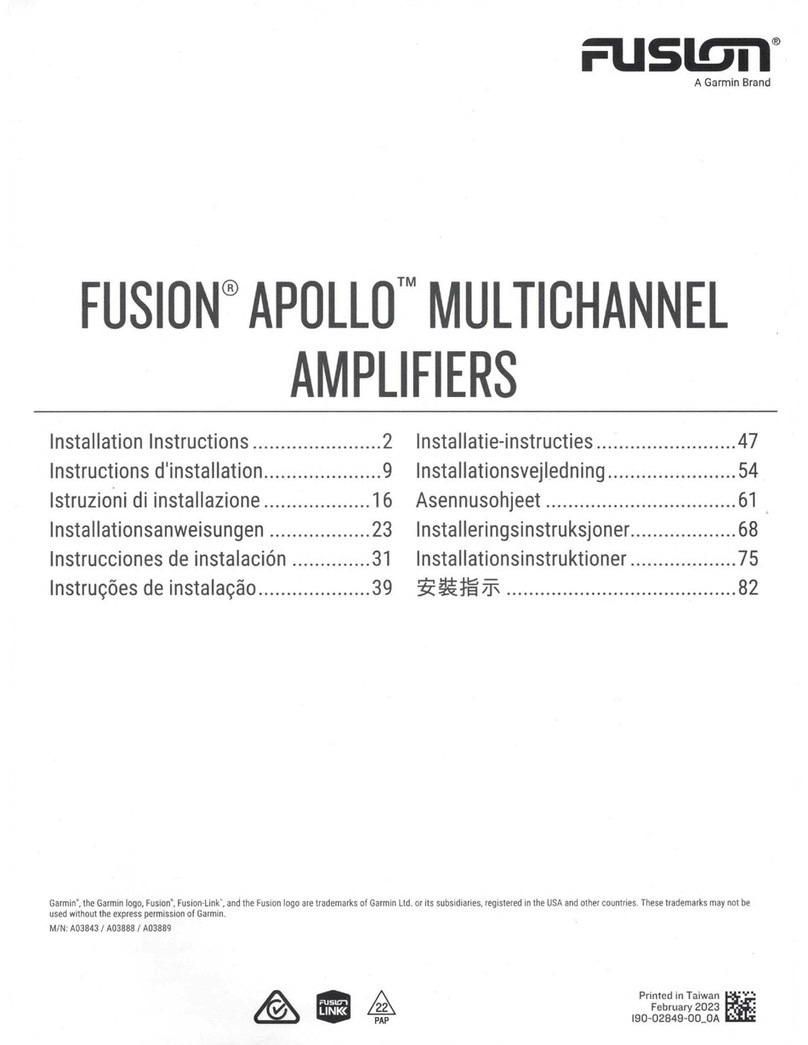
Garmin
Garmin Fusion Apollo MS-AP12000 User manual
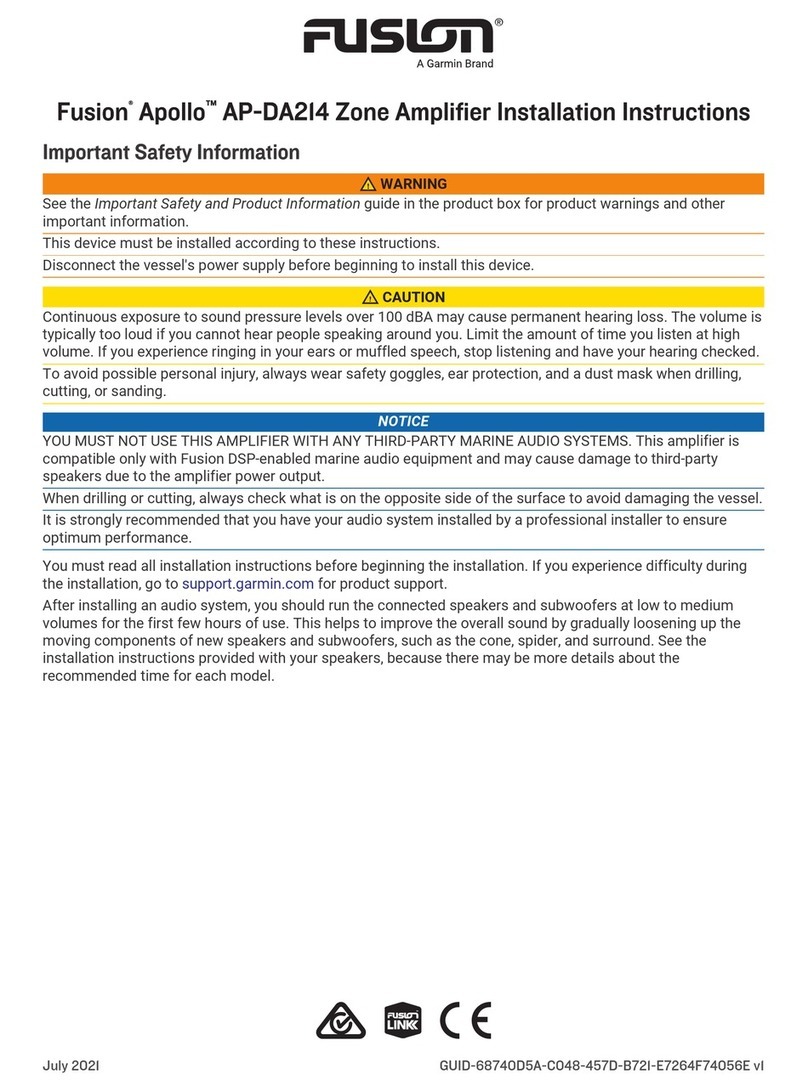
Garmin
Garmin Fusion Apollo AP-DA214 User manual
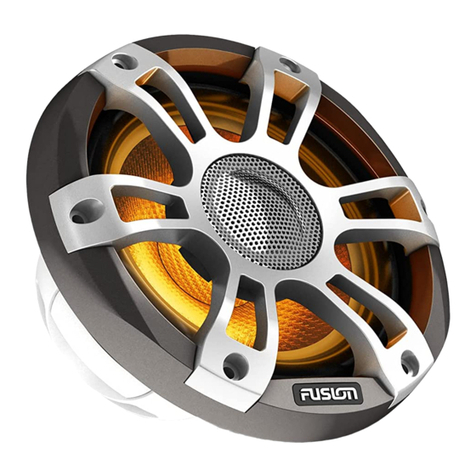
Garmin
Garmin FUSION SIGNATURE Series User manual
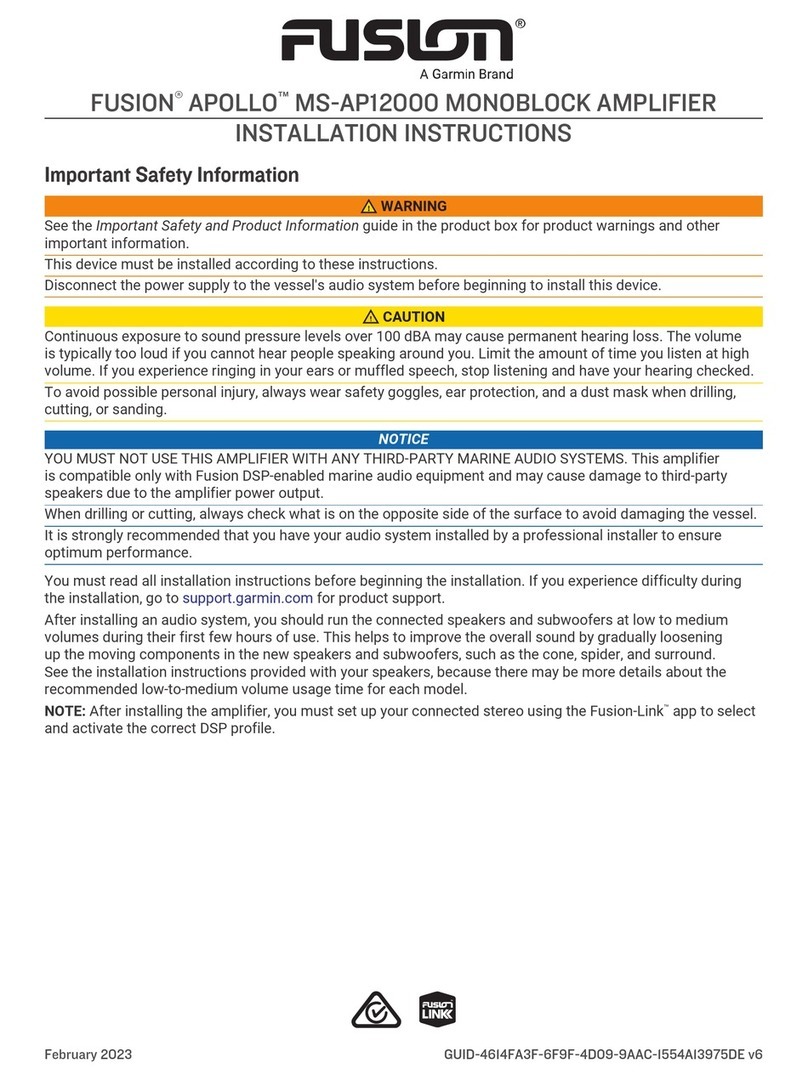
Garmin
Garmin Fusion Apollo MS-AP12000 User manual

Garmin
Garmin SIGNATURE Series User manual
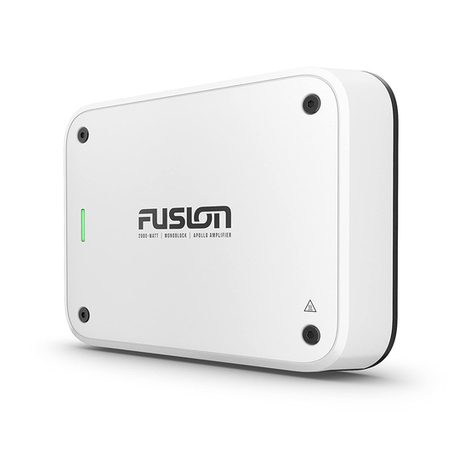
Garmin
Garmin Fusion Apollo MS-AP12000 User manual
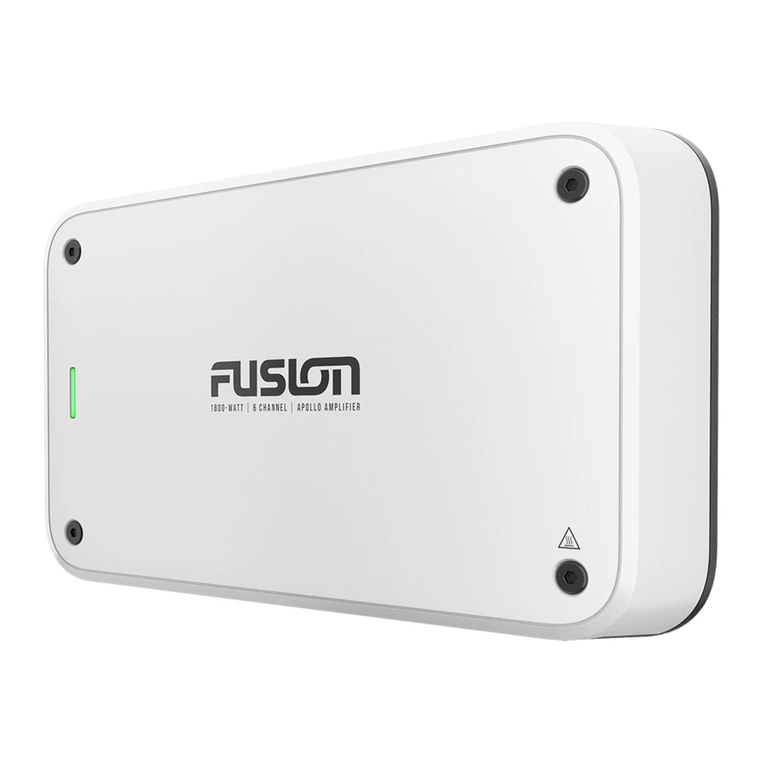
Garmin
Garmin Fusion Apollo Series User manual
Popular Amplifier manuals by other brands

Crest Audio
Crest Audio CKX800 Specifications
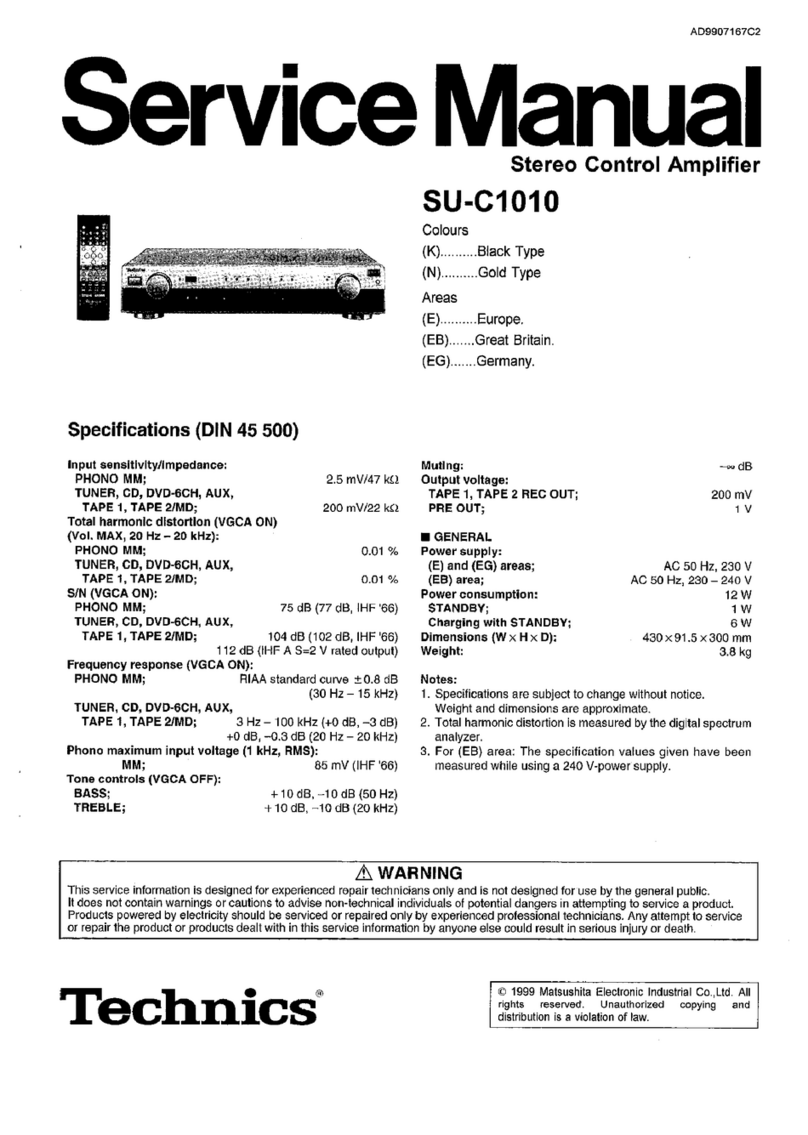
Technics
Technics SU-C1010 Service manual
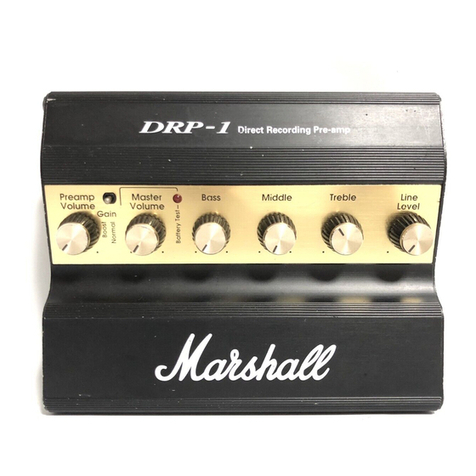
Marshall Amplification
Marshall Amplification DRP-1 instruction manual
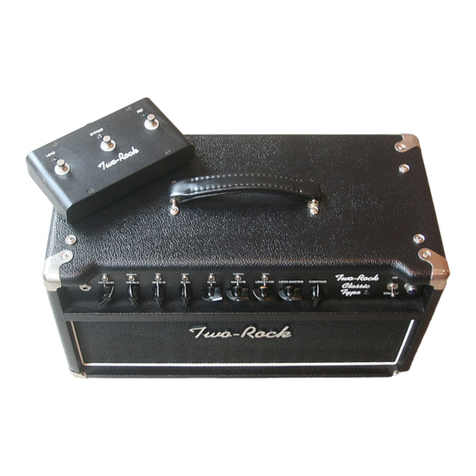
Two-Rock
Two-Rock Classic Type 2 owner's manual

Beyerdynamic
Beyerdynamic A 2 operating instructions

Dave Hill Designs
Dave Hill Designs EUROPA I quick start guide
